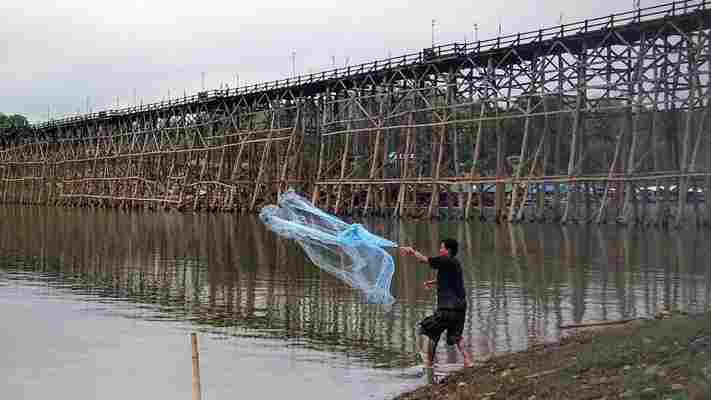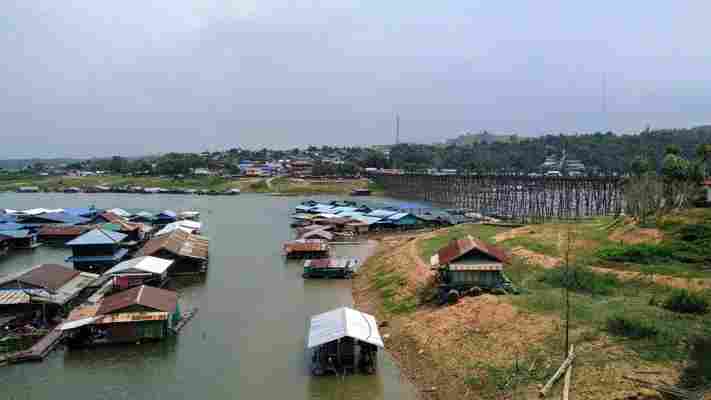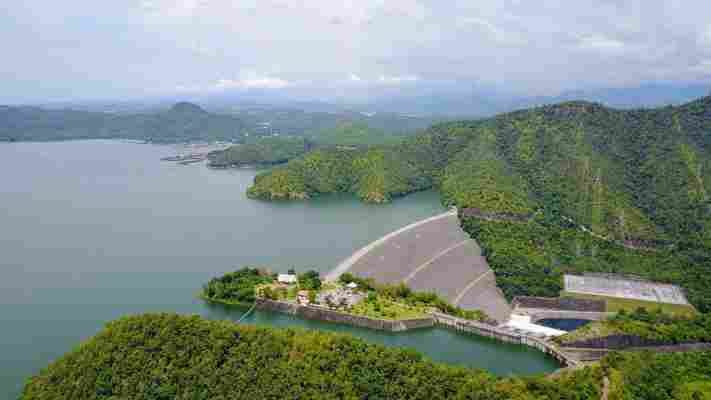

A man fishes near the Mon Bridge in Sangkhlaburi, Thailand
The origins of the remote, mountainous town of Sangkhlaburi in western Thailand are indelibly linked to water. The jagged limestone peaks that surround the town trap fat, plum-coloured clouds, formed by cool air that blows inland from the Andaman Sea over the Myanmar border, that shower the area in rain for at least 300 days a year. The rain feeds three rivers that over millennia have created the Kwai River Valley. (Credit: John McMahon)

The Vajiralongkorn Dam near Sangkhlaburi, Thailand
Thailand's first hydroelectric dam, completed in 1982, was intended to supplement the country’s growing electrical needs and create a reliable source of water to irrigate land across Kanchanaburi province. When the dam was finished, it created the 120,000 sq km Khao Laem reservoir that submerged the small valley town of Sangkhlaburi. Residents moved their homes and business to higher grounds several kilometres away directly across the water from Wang Ka, a village that was settled by the Mon tribe, who had migrated into Thailand from Myanmar to escape persecution. (Credit: John McMahon)
Houseboats on the Sangkalia River in Sangkhlaburi, Thailand
Those who relocated named their new settlement Sangkhlaburi after the village they had lost, and today, the two communities (now referred to collectively as Sangkhlaburi) face each other across the point where the reservoir is fed by the Sangkalia River. On one side, residents speak the Mon, Karen and Burmese languages, and the small streets are lined with traditional bamboo and wooden houses. The opposite riverbank is predominantly Thai. Here, guesthouses and hotels hug the rim of the reservoir while convenience stores and air-conditioned restaurants sit alongside food stalls and mercantile shops.Some families on both sides of town live in floating houses and make their living from fishing and aquaculture. Like floating nomads, they move their homes around the reservoir as water levels change throughout the year. (Credit: John McMahon)
The Mon Bridge in Sangkhlaburi, Thailand
The ‘Mon Bridge’ was built entirely by hand from locally felled teak in 1986 to join the two communities. Remaining upright without any additional support structures, the bridge is the longest freestanding wooden bridge in Thailand and the second longest in the world at 850m. It’s a lifeline that keeps the town connected by allowing traders, schoolchildren and tourists to cross from one side of town to the other on foot. (Credit: John McMahon)
A Mon girl in Sangkhlaburi, Thailand
The Mon were one of the first ethnic groups to inhabit the delta region of eastern Myanmar (formerly known as Burma) after migrating from China more than 1,000 years ago. Over several centuries, many Mon have migrated across the border into Thailand to escape [continuous conflict](https://www.bbc.com/news/world-asia-pacific-11595983) between the Burmese government and various ethnic groups. Several thousand Mon were forced by the Thai government to return to Myanmar in the mid-1990s, but they have since received permission from the Thai government to live in Sangkhlaburi and several other areas around the country, though many are not recognised as Thai citizens. (Credit: John McMahon)
Luk Wah, a resident of Sanghlaburi, Thailand
“I am Mon and I am Thai,” Luk Wah said, as she prepared traditional Mon dishes like fish curry soup in her shop on the Thai side near the foot of the bridge. Her mother, a Mon, came to the town after her home was submerged by the reservoir, and Luk Wah was able to gain Thai citizenship. She and her husband Tong, whom she met after he relocated to Sanghlaburi from Bangkok, see the town as a model community where multiple cultures live together without dispute. “I grew up outside Bangkok in the suburbs. For most of my friends and family, [leaving the city] was unthinkable, but I am happy here, in a quiet town, learning the Mon way to live,” Tong said. (Credit: John McMahon)
People in the market in Sangkhlaburi, Thailand
Even as Sangkhlaburi’s Mon residents have integrated with the Thai community, with Mon schoolchildren attending Thai public school while their parents conduct business on both sides of the water, they take great pride in keeping their culture alive. Away from school, Mon children are taught the languages, songs and stories of their people.Permission for the Mon to reside in the area has attracted ethnic minorities from as far away as Pakistan seeking a peaceful place to live. This diversity is reflected in the fresh market on the Thai side where a multitude of languages are spoken and the food stalls are as likely to serve lentils and roti as they are pad Thai or green curry. (Credit: John McMahon)
Boat on the Sangkalia River near Sangkhlaburi, Thailand
In 2013, the rain-swollen Sangkalia River gathered flotsam against the bridge’s foundation until a 70m span in its centre collapsed into the reservoir. The major effort to rebuild the bridge was [reported across the country](https://www.bangkokpost.com/learning/learning-news/362198/mon-bridge-collapse-heavy-rain-strong-current), raising the town’s profile and ultimately leading to a rise in tourism. Today, visitors are drawn to the natural beauty and architectural sites of the remote region. (Credit: John McMahon)
Wat Saam Prasob, a submerged Mon temple near Sangkhlaburi, Thailand
One such attraction is Wat Saam Prasob, a Mon temple submerged 40 years ago along with old Sangkhlaburi after the dam’s completion. During the November-to-February dry season, as the waters of the reservoir recede, the temple re-emerges from the depths. During this time, a temporary altar is erected in the entrance for worshippers. Incense is burned, prayers chanted and Mon children sell tiny fish, eels and turtles to the devout, who release them back to the reservoir waters as an act of making merit, a Buddhist practice in which believers do good deeds to bring them closer to enlightenment. (Credit: John McMahon)
People walk across the Mon Bridge in Sangkhlaburi, Thailand
Despite the influx of tourists, Sangkhlaburi retains its unique dual personality, with the great wooden span of the Mon Bridge offering passage between the two communities for all. “The border is only a line, not like a mountain, not difficult to cross,” said I Pe Win, who lives on the Mon side. (Credit: John McMahon)
Leave a Comment